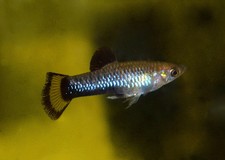Limia melanogaster (Günther 1866)
Etymology:
Limia: Limia derived from the Latin ‘limus’ meaning mud, pertaining to the feeding habits of the fish
melanogaster meaning black abdomen.
First description:
Gunther A, 1866 Catalogue of the Physostomi, containing the families Salmonidae, Percopsidae, Galaxidae, Mormyridae, Gymnarchidae, socidae, Umbridae, Scombresocidae, Cyprinodontidae, in the collection of the British Museum.
Synonyms:
Poecilia melanogaster Günther, 1866
Lebistes melanogaster (Günther, 1866)
History:
This species was originally classified in the genus Limia before this was made a sub-genus of Poecilia. Confusingly they have been reclassified once more into Limia, but are still referred to as members of Poecilia in much of the available literature.
Type Locality:
Not specified
Distribution:
Recorded in rivers near to Kingston and Spanish Town, Jamaica. Also found in other streams, lagoons and springs to the South and West of the island.
Group:
This species belongs to the subgenus Limia
Habitat:
Found in small shallow streams with dense vegetation over a sandy substrate.
Size:
Male 1.6″ (4cm). Female 2″ (5cm).
Description:
Black-bellied Limia has an overall grey body color with a blue sheen. Both sexes are marked with 5-8 dark vertical bars on the rear half of the body. Males have a smaller and more slender body.
Colouration:
Males: The male has a pale yellow dorsal fin, marked with two dark bands: one on the margin, the other on the base, the male’s caudal fin is orange with a dark band.
Females: the female has a clear fin with only one dark bar at the base. females have a large black patch on the belly
Behaviour:
Peaceful and very active
Husbandry:
Prefers a tank with densely planted areas but also plenty of open swimming space hence the relatively large recommended tank size. Also appreciates some floating cover. Temperature should be in the range of 72-82°F (22-28°C) with a pH of 7.5-8.5
Breeding Notes:
Males are vigorous in their pursuit of the females, therefore a heavily planted tank which gives the females somewhere to hide is essential, also the addition of floating plants is also recommended.
The females can drop between 20-50 fry with a gestation period of 4-6 weeks. The fry are large enough to take newly hatched brine shrimp or powdered flake from birth.


